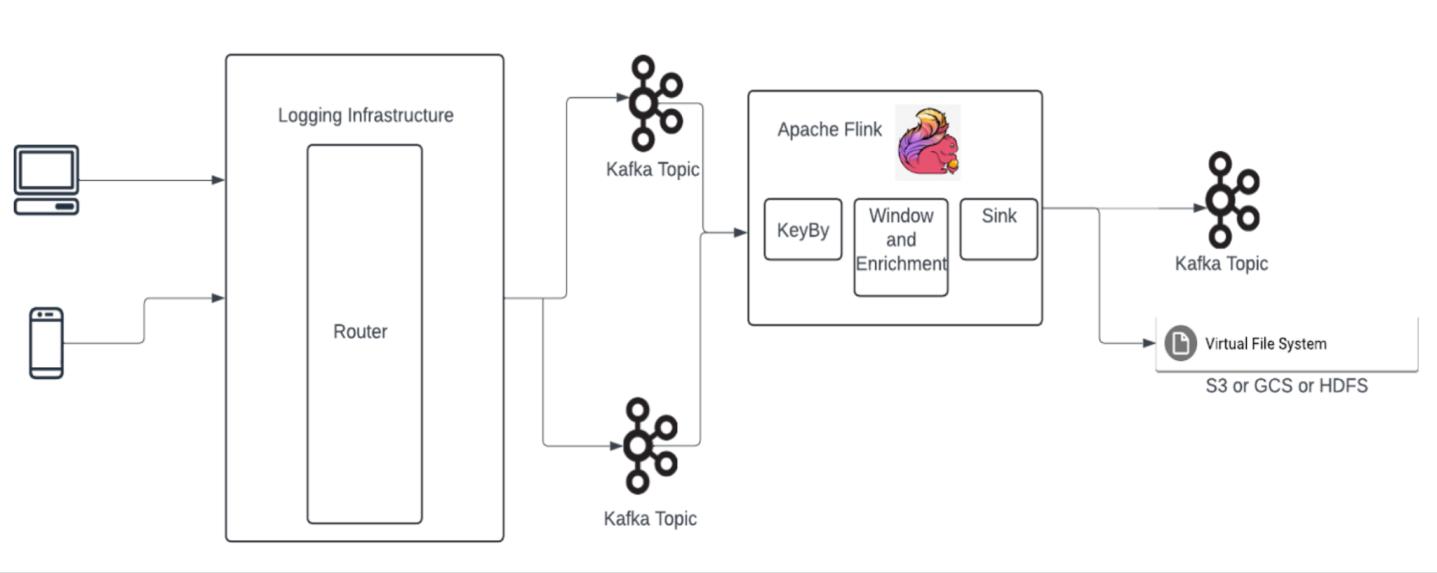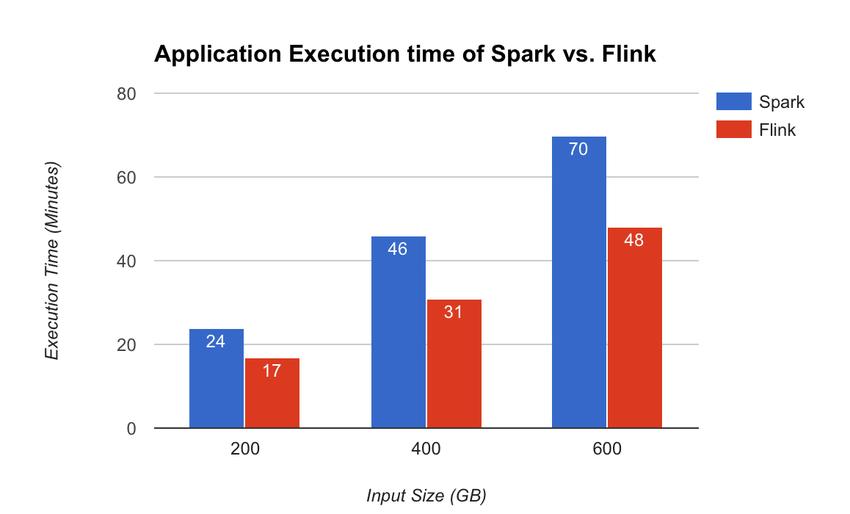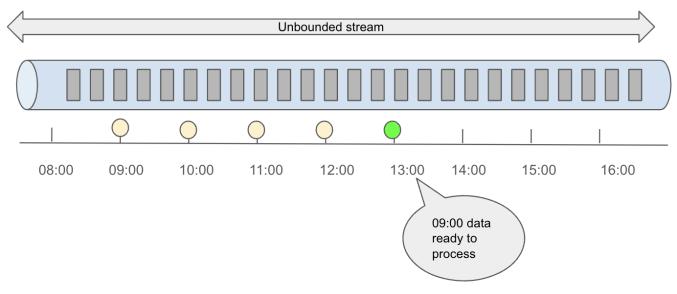
International Research Journal of Engineering and Technology (IRJET) e-ISSN:2395-0056
Volume: 12 Issue: 01 | Jan 2025 www.irjet.net p-ISSN:2395-0072


International Research Journal of Engineering and Technology (IRJET) e-ISSN:2395-0056
Volume: 12 Issue: 01 | Jan 2025 www.irjet.net p-ISSN:2395-0072
Sreyashi Das
Netflix, USA ***
Abstract - Over the last decade, Apache Spark Structured Streaming and Apache Flink have emerged as leading frameworks for real-time data processing. This paper proposes advanced techniques for designing and building reliable streaming components that seamlessly integrate into data pipelines, thereby simplifying data transformations and enhancing query performance. By leveragingSparkStructured Streaming'scapabilities, such as micro-batch processing, adaptive query execution, and enhanced state management, we demonstrate how to ensure scalability and resilience in handling large-scale streaming applications. Additionally, Flink's support for temporal table joins, stateful stream processing, and dynamic table management empowers data practitioners and engineers to efficiently and reliably transform data, meeting the demands of modern data engineering teams and organizations. This paper provides valuable insights into the art of moving and transforming data, offering practical guidance for building robust streaming applications.
Key Words: (streamingdatapipelines,sparkstructured streaming,flink
In the realm of big data, real-time data processing has become essential for organizations seeking to derive immediate insights and maintain a competitive edge. Deploying streaming data pipelines efficiently with high throughput and low latency present challenges due to complex event processing, inconsistent data quality and resource management to optimize query performance. Addressing these challenges, requires a deep-dive into how streaming data pipelines[Fig-1] are implemented for real-world applications. A comparative analysis reveals shifting strengths, with Flink's true stream processingmodel offeringdistinctadvantagesinlatency and state management while Spark structured streaming’sintegrationwithexistingdataecosystem.
This paper explores the intricacies of deploying streaming data pipelines using two prominent frameworks: Apache Spark Structured Streaming and Apache Flink. By examining their historical evolution, technical capabilities, and recent advancements, the paper provides a comprehensive understanding of how these technologies can be leveraged to overcome the
inherent challenges of real-time data processing. Methodologies for building scalable, resilient streaming applicationsarediscussed,highlightingbestpracticesfor optimizing performance and ensuring data quality. Through practical applications the benefits of each framework are illustrated, offering insights into their uniquestrengthsandtrade-offs.
Furthermore, the paper discusses the future directions ofstreamprocessing,includingtheintegrationofAI/ML and edge computing, and how these trends are shaping the next generation of data pipelines. This paper serves as a valuable resource for data practitioners and engineers, providing guidance on selecting and implementing the right streaming solutions to meet the demandsofmoderndata-drivenorganizations.
Theearly2000smarkedthebeginningofashifttowards real-time data processing, driven by the need for immediateinsightsfromdataasitwasgenerated.Initial solutionswereoftenlimited inscalabilityandflexibility. The introduction of Apache Spark in 2009, followed by Spark Streaming in 2013, provided a robust framework for processing live data streams using a micro-batch model[Fig-3].
Apache Flink, initially developed as Stratosphere in 2009, introduced a true stream processing model in 2014. Flink's ability to handle data in real-time with event time semantics and stateful computations distinguisheditfromotherframeworks.
Table -1: KeyMilestonesofstreamprocessing
Key Milestones
2013 SparkStreamingintroducedmicro-batch processing, enabling seamless integrationwiththeSparkecosystem
2014 Apache Flink released with a focus on low-latency, high-throughput stream processing
2016 Flink introduced exactly-once state consistency, revolutionizing stateful streamprocessing

International Research Journal of Engineering and Technology (IRJET) e-ISSN:2395-0056
Volume: 12 Issue: 01 | Jan 2025 www.irjet.net p-ISSN:2395-0072
2018 Spark Structured Streaming offered a unified and declarative API for stream processing
2020s Both frameworks continued to evolve, enhancing state management, fault tolerance,andintegrationcapabilities
Fig -1:Exampleofreal-timedatapipeline
complex data processing workflows that combine realtimeandhistoricaldataanalysis.
One of the critical features of Spark Structured Streaming is its ability to provide exactly-once processingsemantics.Thismeansthateachrecordinthe input data is processed exactly once, even in the

3.1
Spark Structured Streaming provides a high-level declarative API that allows users to express streaming computations in a SQL-like syntax. This approach simplifies the development of streaming applications by abstractingthecomplexities ofstreamprocessing.Users familiar with batch processing in Spark can easily transition to streaming applications without needing to learnanewprogrammingmodel.Thedeclarativenature of the API enables automatic optimization of query execution plans, improving performance and resource utilization.
In Spark Structured Streaming, stream data is represented as DataFrames and Datasets, which are distributed collections of data organized into named columns. This representation allows streaming data to be processed using the same APIs and optimizations available for batch data. By leveraging DataFrames and Datasets, users can seamlessly integrate streaming data withSpark'srichecosystem,including machinelearning (MLlib), graph processing (GraphX), and data manipulation libraries. This integration facilitates
presence of failures. This guarantee is achieved through a combination of checkpointing and write-ahead logs, whichensurethatthesystemcanrecovertoaconsistent stateafterafailure.Exactly-onceprocessingiscrucialfor applications that require high reliability and accuracy, suchasfinancialtransactionsandmonitoringsystems.
Spark Structured Streaming supports advanced windowing operations that enable users to perform time-basedaggregationsandanalysesonstreamingdata. Windowing functions allow users to group data into fixed-size or sliding windows based on event time or processing time. This capability is essential for applications that require temporal analysis, such as trend detection, anomaly detection, and real-time reporting. The framework provides a variety of windowingoptions,includingtumblingwindows,sliding windows,andsessionwindows,allowinguserstochoose the most appropriate windowing strategy for their use case.
Apache Flink is designed as a true stream processing framework, meaning it processes data as it arrives, rather than in micro-batches. This architecture allows

International Research Journal of Engineering and Technology (IRJET) e-ISSN:2395-0056
Volume: 12 Issue: 01 | Jan 2025 www.irjet.net p-ISSN:2395-0072
Flink to achieve low-latency processing, making it ideal for applications that require real-time insights and immediate responses, such as fraud detection, monitoring, and alerting systems. By processing each event individually, Flink can provide more granular control over data processing andtime management[Fig2], which is crucial for applications with stringent latencyrequirements.
Flink offers robust support for event time semantics, which is essential for accurately processing events that may arrive out of order or with delays. Event time processing allows Flink to use timestamps embedded in the data to determine the order of events, rather than relyingonthetimetheyareprocessed.Thiscapabilityis particularly important for applications that require precisetime-basedoperations,suchasbillingsystemsor time-series analysis. Flink's event time semantics are complemented by its support for watermarks, which help manage the trade-off between latency and completenessbyindicatingtheprogressofeventtimein thestream.
4.3
Flink excels in stateful stream processing, providing advanced state management capabilities with exactlyonce consistency guarantees. This means that Flink can maintain and update state information across events, enabling complex computations that depend on historical data, such as aggregations, joins, and pattern detection. Flink's state management is highly efficient, allowing it to handle large state sizes with minimal overhead. The framework supports various state backends, such as in-memory, RocksDB, and custom implementations, giving users flexibility in choosing the most suitable storage mechanism for their application's needs.
4.4
Flink provides robust fault tolerance mechanisms to ensure reliable stream processing even in the presence of failures. It achieves this through a combination of checkpointing and distributed snapshots, which capture the state of the application at regular intervals. In the eventofafailure,Flinkcanrecovertothelastconsistent state using these checkpoints, ensuring that no data is lost and that exactly-once processing semantics are maintained. This fault tolerance is critical for applicationsthatrequirehighavailabilityandreliability, such as financial services and critical infrastructure monitoring.

5. Comparison between Spark structured streaming and Flink
5.1 Data enrichment
Data enrichment involves augmenting streaming data with additional information, often by calling external APIsordatabases.Thisprocesscanenhancethevalueof thedatabyprovidingmorecontextorinsights.
Both Spark and Flink allow calling external APIs from UDFs, but there are important considerations regarding performanceandscalability.
High Request Rate: UDFs are called for every record processed, potentially leading to a high request rate to theexternalAPI.
Parallel Execution: In production, UDFs run in parallel across multiple nodes, further amplifying the request rate.
Asynchronous I/O: To maintain high throughput, especially for I/O-bound operations, consider using asynchronousI/O.
Spark Structured Streaming Example
Example:EnrichingWeatherDatawithExternalAPI
Suppose you have a streaming DataFrame of weather station readings, and you want to enrich each record with additional weather information from an external API.
defcall_weather_api(station_id):
# Simulate an external API call to get weatherdetails
response=get_weather_details(station_id) returnresponse
#DefineaUDFfortheexternalAPIcall

International Research Journal of Engineering and Technology (IRJET) e-ISSN:2395-0056
Volume: 12 Issue: 01 | Jan 2025 www.irjet.net p-ISSN:2395-0072
enrich_weather_data = udf(call_weather_api, StringType())
weather_readings=... #StreamingDataFrame with schema: station_id, reading_time, temperature
#Enrichweatherreadingswithexternaldata enriched_weather_readings = weather_readings.withColumn("enriched_data", enrich_weather_data(weather_readings.station_ id))
In this Spark example, a UDF enrich_weather_data is defined to call an external API for each station_id. The enriched data is added as a new column to the weather_readingsDataFrame.
Apache Flink Example
Example:EnrichingTrafficDatawithExternalAPI
Suppose you have a stream of traffic sensor data, and you want to enrich each record with additional traffic informationfromaRESTAPI.
//DefineaUDFfortheexternalAPIcall public class CallTrafficAPIUDF extends ScalarFunction{ publicStringeval(Stringsensor_id){
// Simulate an external API call to get trafficdetails
String response = getTrafficDetails(sensor_id); returnresponse; } }
// Register and use the UDF in a Flink SQL query
StreamTableEnvironmenttableEnv=...; tableEnv.createTemporarySystemFunction("callT rafficAPIUDF",CallTrafficAPIUDF.class);
tableEnv.executeSql("SELECT sensor_id, callTrafficAPIUDF(sensor_id) AS enriched_traffic"+ "FROMtraffic_sensors" );
InthisFlinkexample,aUDFCallTrafficAPIUDFisdefined to call an external API for each sensor_id. The enriched dataisretrievedusingaFlinkSQLquery.
Use UDFs Judiciously: Improperly implemented UDFs canslowdownprocessing,causebackpressure,andstall theapplication.
Asynchronous I/O: Consider using asynchronous I/O for UDFs, especially when dealing with external resources like databases or REST APIs. This approach canhelpmaintainhighthroughputandreducelatency.
Rate Limiting and Caching: Implement rate limiting and caching strategies to manage the request rate to externalAPIsandreduceredundantcalls.
Both Spark Structured Streaming and Apache Flink support event time processing, allowing users to define time windows based on event timestamps rather than processingtime.Watermarkingisakeymechanismused tomanagelate-arrivingdata,settingathresholdforhow long the system should wait for delayed events before consideringthemtoolatetoprocess.
Spark Structured Streaming Example
Example:ProcessingE-commerceOrderEvents
Consider a streaming DataFrame of e-commerce order events, where each event includes an order_id, order_time, and amount. You want to calculate the total order amount in 10-minute windows, allowing for late arrivalsupto5minutes.
orders = ... # Streaming DataFrame with schema:order_id,order_time,amount # Calculate total order amount in 10-minute windows,allowingfor5minutesoflateness
totalOrderAmount=orders\ .withWatermark("order_time","5minutes")\ .groupBy(window(orders.order_time, "10 minutes"))\ .sum("amount")
In this example, the withWatermark method specifies a 5-minute lateness threshold. Events arriving within 5 minutes of the window's end will be included in the aggregation,whilethosearrivinglaterwillbediscarded.
Apache Flink Example
Example:AnalyzingSocialMediaPosts
Considerastreamofsocialmediaposts,whereeachpost includes a post_id, post_time, and content. You want to

International Research Journal of Engineering and Technology (IRJET) e-ISSN:2395-0056
Volume: 12 Issue: 01 | Jan 2025 www.irjet.net p-ISSN:2395-0072
count the number of posts in 15-minute windows, allowingforlatearrivalsupto2minutes.
CREATETABLEsocial_media_posts( post_idSTRING, post_timeTIMESTAMP(3), contentSTRING,
WATERMARK FOR post_time AS post_timeINTERVAL'2'MINUTE );
SELECT window_start, COUNT(post_id) AS post_count
FROMTABLE(
TUMBLE(TABLE social_media_posts, DESCRIPTOR(post_time), INTERVAL '15' MINUTES))
GROUPBYwindow_start;
In this Flink SQL example, the watermark is defined in theDDL witha 2-minutelatenessthreshold.Thisallows thesystemtoincludepostsarrivingupto2minuteslate inthe15-minutewindowcount.
Windowing
Spark Structured Streaming Tumbling Window
Example:AggregatingWebsiteClicks
Supposeyouwanttocalculatethetotalnumberofclicks onawebsitein15-minuteintervals.
clicks = ... # Streaming DataFrame with schema:user_id,click_time
# Count clicks in a tumbling window of size 15minutes
clicksByWindow=clicks\ .withWatermark("click_time", "5 minutes") \ .groupBy( window(clicks.click_time, "15 minutes"))\ .count()
In this example, a tumbling window of 15 minutes is usedtocountthenumberofclicks,withawatermarkto handlelatedata.
Apache Flink Tumbling Window
Example:SummingSalesTransactions
Consider a stream of sales transactions where you want tocalculatethetotalsalesamountevery30minutes.
astreamofsocialmediaposts,whereeachpostincludes a post_id, post_time, and content. You want to count the numberofpostsin15-minutewindows,allowingforlate arrivalsupto2minutes.
SELECT window_start, SUM(amount) AS total_sales FROMTABLE(
TUMBLE(TABLE sales_transactions, DESCRIPTOR(transaction_time), INTERVAL '30' MINUTES))
GROUPBYwindow_start;
In this Flink SQL example, a tumbling window of 30 minutes is applied to sum the amount of sales transactions.
Spark Structured Streaming Sliding Window
Example:MonitoringTemperatureChanges
Suppose you want to monitor temperature changes using a sliding window of 20 minutes with a slide intervalof10minutes.
temperature_readings = ... # Streaming DataFrame with schema: sensor_id, temperature,reading_time
# Calculate average temperature in a sliding window of size 20 minutes and slide interval of10minutes
avgTemperatureByWindow = temperature_readings \ .withWatermark("reading_time", "10 minutes")\ .groupBy(
window(temperature_readings.reading_time, "20 minutes","10minutes"))\ .avg("temperature")
Inthisexample,aslidingwindowisusedtocalculatethe averagetemperature,allowingforoverlappinganalysis.

International Research Journal of Engineering and Technology (IRJET) e-ISSN:2395-0056
Volume: 12 Issue: 01 | Jan 2025 www.irjet.net p-ISSN:2395-0072
Apache Flink Sliding Window
Example:AnalyzingNetworkTraffic
Consider a stream of network traffic data where you wanttocalculatetheaveragedatarateovera10-minute windowwitha5-minuteslideinterval.
SELECT window_start, AVG(data_rate) AS avg_rate
FROMTABLE(
HOP(TABLE network_traffic, DESCRIPTOR(event_time),INTERVAL'5'MINUTES, INTERVAL'10'MINUTES))
GROUPBYwindow_start;
In this Flink SQL example, a sliding window is used to compute the average data_rate, providing insights into networkperformanceovertime.
Spark vs Flink: How to choose
6.1 Latency Sensitivity:
Evaluatetheimportanceoflow-latencyprocessinginthe application.Flink'struestreamprocessingmodelmaybe more suitable for applications requiring immediate data processingandlow-latencyresponses.
6.2 Stateful Processing Needs:
Consider the complexity and scale of stateful computations required by the application. Flink's advanced state management capabilities may offer advantages for applications with complex stateful processingrequirements.
6.3 Event Time Handling:
Assess the importance of precise event time processing and handling of out-of-order events. Flink's robust support for event time semantics may be beneficial for applications that rely heavily on accurate time-based operations.
6.4 Development and Maintenance:
Consider the ease of development and ongoing maintenance. Spark's larger ecosystem and community support maysimplify developmentandtroubleshooting, while Flink's intuitive APIs may reduce development timeforstreamprocessingtasks.
6.5 Resource Management and Cost:
Evaluate the resource management capabilities and potential cost implications of each framework. Consider how each framework's resource utilization aligns with theproject'sbudgetandinfrastructureconstraints.
6.6 Scalability and Throughput:
Determine the scalability and throughput requirements of the application. Both frameworks are designed to scale, but specific architectural features may influence theirperformanceatscale.
6.6 Use Case Alignment:
Alignthechoiceofframeworkwiththespecificusecases and industry requirements of the project. Consider how each framework's strengths align with the unique demandsoftheapplicationdomain.
6.7 Future Growth and Flexibility:
Considerthepotentialforfuturegrowthandtheneedfor flexibility in the data processing architecture. Evaluate how each framework can adapt to evolving data processingneedsandemergingtechnologies.
In conclusion, Apache Spark and Apache Flink stand as titans in the realm of distributed data processing, each offering a distinct set of strengths that cater to the diverse needs of modern data engineering. Spark, with its robust batch processing capabilities and extensive language support, provides a comprehensive platform foramyriadofusecases,fromETLprocessestocomplex machine learning pipelines. Its mature ecosystem and widespread adoption make it a reliable choice for organizations seeking a versatile and well-supported framework.
Conversely, Apache Flink emerges as the vanguard of stream processing, delivering unparalleled low-latency performance and sophisticated windowing capabilities that are indispensable for real-time analytics. Flink's architecture is meticulously crafted to handle the intricacies of event time processing and stateful computations, making it the framework of choice for applicationsthatdemandimmediacyandprecision.
ThedecisiontoadoptSparkorFlinkshouldbeguidedby a nuanced understanding of the specific requirements andconstraints ofthe projectathand.Experienced data engineers must weigh factors such as processing paradigms, latency tolerances, iterative processing needs, and the existing technological landscape. Moreover, the expertise of the team and the strategic goals of the organization play pivotal roles in this decision-makingprocess.
Conducting rigorous proof-of-concept evaluations and benchmarking both frameworks against real-world scenarios can provide invaluable insights into their performanceandsuitability.Suchempiricalassessments, coupled with a strategic vision, will empower organizations to make informed choices that align with theirdataprocessingobjectives.
As the field of big data continues to evolve, both Spark and Flink are poised to adapt and innovate, driven by vibrant open-source communities and cutting-edge research.Stayingabreastofthelatestadvancementsand leveraging the unique capabilities of these frameworks

International Research Journal of Engineering and Technology (IRJET) e-ISSN:2395-0056
Volume: 12 Issue: 01 | Jan 2025 www.irjet.net p-ISSN:2395-0072
will enable data engineers to push the boundaries of what is possible, transforming data into actionable insights and driving the next wave of technological innovation.
[1] Hesse, G., & Lorenz, M. (2015). Conceptual Survey on Data Stream Processing Systems. 2015 IEEE 21st International Conference on Parallel and Distributed Systems(ICPADS).doi:10.1109/icpads.2015.106
[2] Real-time Data Stream Processing - Challenges and Perspectives. (2017). International Journal of Computer Science Issues, 14(5), 6–12. doi: 10.20943/01201705.612
[3] Kolajo,T.,Daramola,O.,&Adebiyi,A.(2019).Bigdata streamanalysis:asystematicliteraturereview.Journalof BigData,6(1).doi:10.1186/s40537-019-0210-7
[4]https://www.macrometa.com/event-streamprocessing/spark-vs-flink
[5]https://www.dataversity.net/spark-vs-flink-keydifferences-and-how-to-choose/l Intelligence Volume 82,June2019,Pages126147
[6]https://learning.oreilly.com/library/view/streamingsystems/9781491983867/
[7]https://www.researchgate.net/figure/Execution-timecomparison-for-different-input-sizes_fig2_309192139
[8]“Benchmarking Streaming Computation Engines at... Yahoo Engineering,” [accessed 6-January-2016]. [Online].
Available: http://yahooeng.tumblr.com/post/135321837876/ benchmarking-streaming-computation-engines-at
[9]R.Lu,G.Wu,B.Xie,andJ.Hu,“StreamBench:Towards Benchmarking Modern Distributed Stream Computing Frameworks,” in 2014 IEEE/ACM 7th International Conference on Utility and Cloud Computing. IEEE, dec 2014,pp.69–78.
[Online].Available:http://ieeexplore.ieee.org/articleDeta ils.jsp?arnumber=7027482
[10]“Apache Flink: Scalable Batch and Stream Data Processing,” [accessed 6-January-2016]. [Online]. Available:https://flink.apache.org/
[11]“Apache SparkTM - Lightning-Fast Cluster Computing,” [accessed 6-January-2016]. [Online]. Available:https://spark.apache.org/[3]

Fig -3:Micro-batchinSparkStreaming